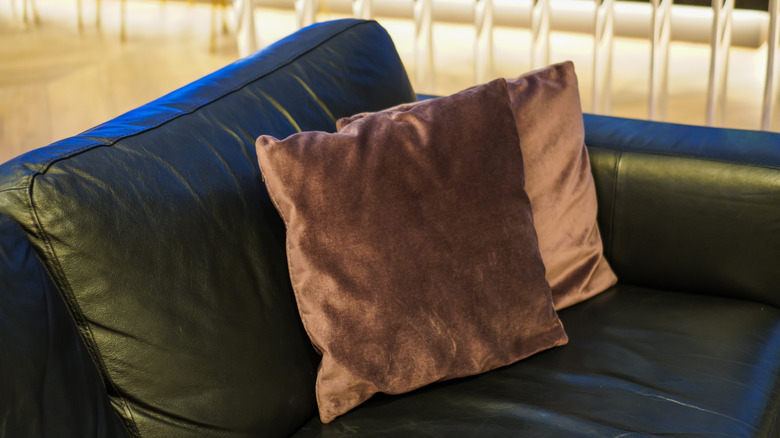The Best Interior Design Tip For Beginners—and It Doesn't Cost A Dime
In your fantasy decorating world, budget is no object, and a double set of Charles and Ray Eames chairs with matching footstool takes center stage. In the real world, your home decorating budget might be closer to zero. Or, if you're lucky, it'll be maybe a couple hundred bucks and won't include the designer chairs. This isn't the time to be discouraged, however. It's the time to get clever with the use of visual rhythm, which costs you nothing except a bit of planning time and can offer even more decorative benefits than a room filled with designer chairs.
Visual rhythm is established by repeating the same elements over and over again in a room. That could be using the same cobalt blue you've painted on an accent wall for your couch cushions and throw rugs. Visual rhythm could be with a repeating pattern, texture, material, or even a type of fixture, like the pendant lights above the sofa. Each of these different elements set on repeat throughout the space creates a sense of flow and makes a mismatched room look purposeful. There's no need to buy new items either — use the concept of visual rhythm to rearrange items in a space or shift pieces you already have from one room to another.
Visual rhythm is also handy to use if you have an open-concept living space and you want to create different areas within it. For example, the red vinyl and chrome table and chairs you've chosen for the dining area contrast the rough texture of the couch's fabric. However, the same color of red is repeated on the sofa's throw cushions. This allows the eye to move easily from one area to the next without causing a jarring effect in the process.
Practical ways to build visual rhythm in a room
Like most principles of interior design, visual rhythm isn't usually a concept that stands on its own. It's used in tandem with other design concepts to make a stunning whole. For example, an interior designer will repeat a circular or cylindrical shape by placing three matching vases together in a cluster. Such a grouping not only repeats a dominant shape and possibly reinforces a color scheme or gradient, but it also taps into the rule of three. This concept says that items placed in clusters of threes give a grouping more visual appeal, and the idea can also be applied to any odd-numbered grouping of objects.
The arrangement encourages the eye to stop for a second to visually drink in the group of three items before moving on to other elements in the room. It should be noted as well that your design scheme might feature more than one cluster of three items, like three throw pillows on the couch or a few stacks of three books on the bookshelf.
The vases might additionally employ the use of scale when strategically placed at the same height as a bench or if they mirror the size of the logs in a basket by the fireplace. Not all of the objects will be this same height or size, but a few of them should provide height or size continuity within the larger decorating scheme. A room featuring clusters of items of similar heights should be one of your decorating goals.
Add more visual interest by introducing opposing rhythms
One of the more interesting aspects of working with visual rhythm in a room is the purposeful introduction of opposing or opposite elements. Here's an example of what that means. You have a mid-century modern couch with matching side chairs. With their slick leather seats and smooth chrome legs, they provide a visual and textural juxtaposition to the shaggy rug that lies underneath the pairing. It's all about intentionally creating contrast between the smooth furniture and the rough rug. It may seem counterintuitive when it comes to creating visual rhythm, but actually, our eyes better "understand" the room's visual rhythm not only because of the repeating elements but also because of the elements that break the pattern in some ways.
There are a number of ways you can augment the opposing design elements in a space, like using complementary colors together. For example, place light pink cushions on a mint green couch. Throughout the room, the color scheme would include both the green and the pink, so you'd have a repeating color element in the space to create visual rhythm. However, since the two colors are complements on the color wheel, you'd also have the necessary contrast to make the space look interesting. You can add even more juxtaposing elements by putting round pillows on the rectangular sofa or by opting for pillows with velvet fabric to contrast with the smoothness of the couch's leather exterior.


